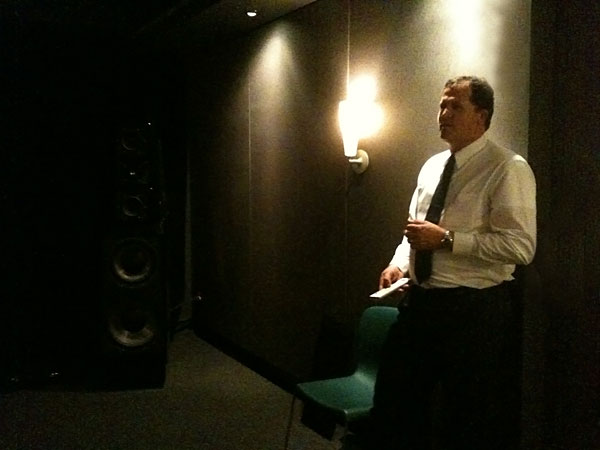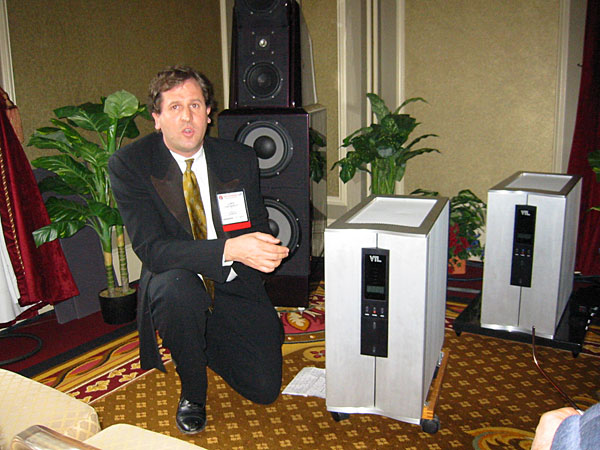Download
Popular Posts
-
Gibboni and the Gibbon: At Stereo Exchange’s annual Spring High-End Audio Show, Roger Gibboni (left) of Rogers High Fidelity debu...
-
Hey, we were in earthquake country, the land from which Carole King may have received inspiration to write, "I Feel the Earth Move...
-
A reader once noted that I tend to stick with the same reference gear longer than most reviewers. In addition to Audience's Au24e i...
-
John Atkinson and Stephen Mejias were unable to attend the Munich High End Show this year, so the call went out to the editors of Ste...
-
Today, Sony announced an end to production on all MiniDisc players. In a few years, MiniDisc production will cease as well. I know w...
-
The name sounds perfect . It fits neatly next to those of Messrs. Leak, Sugden, Walker , Grant, Lumley, and others of Britain's...
-
The Enigmacoustics company from Irvine in California has become renowned for the self-energized, horn-loaded Sopranino electrostatic su...
-
With the introduction of Audio Alchemy's Digital Transmission Interface (DTI) more than three years ago, the company created an ent...
-
If it's rare to go to an audio show and hear most of a company's products set up properly in multiple rooms, it's rarer sti...
-
The floorstanding Canalis loudspeakers in the Spiral Groove room, driven by Qualia digital source and amplification, were new to me, bu...
Market information
Blog Archive
-
▼
2013
(510)
-
▼
May
(29)
- Westone 4R In-ear Headphone Sweepstakes
- Maria Schneider’s Winter Morning Walks
- Aidan Baker: On Music, Sound, and Already Drowning
- Roy Gandy: 40 Years of Reganomics
- Recording of June 2013: Already Drowning
- Nordost Premiers the Valhalla 2
- Your Show of Shows: Newport Beach 2013 Starts Friday
- Payday Albums: 5/24/13
- 21 Tracks for Newport Beach: A Playlist
- VTL's Luke Manley
- How Not to Change a Tweeter
- Broken Deer: Polaraura
- Focal XS Book Music System Sweepstakes
- Velodyne DF-661 loudspeaker
- Tony Wins Some Schiit
- Passion of the Hi-Fi: Part VI - Resolution
- Boston Acoustics A40 loudspeaker
- Altec Lansing 301 loudspeaker
- A Unique Attention Screen Recording Concert in NYC...
- Released Today: Anamanaguchi’s Endless Fantasy
- Munich: A Few Of My Favorite Things
- Munich High End 2013
- Audiophile Essentials Packages Now Available
- Javelin Live at Brooklyn Bowl
- M2Tech Young D/A processor & Palmer Power Station ...
- Listening #125
- Passion of the Hi-Fi: Part V – Imbalance
- Remix: UNKWON Does “Love and Respect” by When Sain...
- 2013 Jazz Journalism Awards
-
▼
May
(29)
VTL's Luke Manley

Luke Manley: My dad, David Manley, and I co-founded VTL in June of 1986. We started small on the East Coast, and soon after we moved to California.
Scull: Is it because you're really a West Coast kind of guy?
Manley: [laughs] You bet! There's a lot of supporting industries out there; a big base of electronics manufacturers, for example.
Scull: What, in the San Francisco area?
Manley: No, I'm speaking about Los Angeles. Even though I live near San Francisco, I keep the factory down there. You know, those support industries I mentioned—metalworkers, transformer vendors, distributors, and so on. Also, this way I keep the same core crew that I've had since we moved to California in '87.
Scull: I suppose it's inevitable that I ask you if you'd clarify the relationship between you and papa David at Manley Labs.
Manley: We've been totally separate companies since April 1993, and neither one of us has any financial interest in the other's concern. My dad designed the basic circuit topology—a parallel input stage, a longtail splitter, and a push-pull output stage with certain specifications, like stiff power supplies, a certain amount of capacitance in the power supply, solid-state diodes, and a particular type of transformer wind.
Scull: Let's talk about the transformers for a moment. You do not source them from Manley Labs?
Manley: That's right.
Scull: Would you care to elaborate?
Manley: Sure. Our premium output transformer is called the Signature. We took the Magic Transformer design and improved it substantially. I'm speaking about the transformer that was made for us before Dad started winding his own in-house. The way it was made by the previous vendor was not the quality we needed, so we found another whose work is far superior.
Scull: ...and who shall remain nameless?
Manley: Well, I can say that the new vendor has a much cleaner operation. I spent about a year with them getting this new transformer organized with them.
Scull: Your transformers are really enormous...
Manley: In this amplifier, yeah.
Scull: Besides their immense girth, what are some of their special features?
Manley: The Signature transformer's major strength is that it can deliver the current in the bass while maintaining the speed in the high frequencies, dramatically improving the squarewave response. That means a much cleaner sound. The biggest challenge with designing a big output transformer is that it needs to be as big as possible to handle the bass current, but it gets harder and harder to keep up the speed in the top end as the size of the transformer increases. If the coupling is not done carefully, the capacitance and leakage inductance will roll-off the highs. We manage this by substantially increasing the number of sections over the previous output transformers, improving the coupling between the primary and secondary windings, and even between the individual wires. This increases efficiency by lowering insertion loss. The multiple sections and better winding-to-winding coupling gives the amplifier the capability to pass [full power] right out to the frequency extremes.

Another thing: the primary impedance of the transformer is more precisely matched to the plate impedance of the output tubes, and with the impedance set for an optimum speaker load of 5 ohms, you get the most efficient current transfer from the power tubes to the speaker load. This in turn allows our amps to better handle fluctuations in speaker impedance, and gives much more flexibility in handling a wider range of speaker loads.
Scull: Can current owners of VTL amps upgrade?
Manley: Yes, the Signature transformer can be retrofitted to VTL amps already out in the field.
Scull: How much loop negative feedback do you run in these monsters—the Wotan '1250s?
Manley: 14dB.
Scull: Obviously you're not afraid of feedback...
Manley: Right. A small amount is something that's pretty good to have. It's necessary to keep the amplifier under control and prevent oscillations.
Scull: 14dB is considered "low" feedback?
Manley: Less than 20dB is considered low. You know, negative feedback got a bad name—I'm quoting from The VTL Book—from the days when people would rely on it to panel-beat the circuits straight. And they weren't even making good-sounding circuits to begin with! If you use feedback for what it's really intended for, then a small amount is okay. Tubes are inherently feedback devices, you know, by the way they operate.
Scull: What would you say to someone who's afraid of tubes? I mean, twenty-four 6550s per side in the Wotan is enough to send someone with a weak constitution into tube shock!
Manley: I would say tubes sound much more musical than transistors, and that's really the bottom line. I don't deny that some people may prefer the sound of transistors, but I think if you listen for the music, tubes are better.
Of course, tube designs do operate at higher voltages. And when things do go, it can be quite spectacular. But at VTL we go to great lengths to keep that sort of thing from happening. You don't have to take it into the shop to change tubes, for example. The Wotan features individual bias-trim pots, so you don't need matched sets of tubes.
Scull: What happens when a tube goes down?
Manley: They're set up so that if a tube blows, it takes out the fuse and nothing else. You replace the tube and the high-tension fuse, and you're on your way again. All you have to do is re-bias it. Let me tell you, that's a lot easier than replacing a transistor. Don't forget, if one should fail, the new transistor has to be matched with the rest—no easy pull'n'plug.
Scull: What possessed you to create this kind of a statement product for VTL?
Manley: I want to communicate to people that VTL makes high-power tube amplifiers. You know, 24 tubes per side ought to get the message across! And, as for the high power, I believe you really need lots to control a speaker. 1250W will really grab hold and control most speakers you can name. To my ear, that's where the performance comes from.
Scull: And you prefer triode mode yourself?
Manley: No doubt. Your Avalons are 86–87dB sensitivity, right? 600W should be enough power.
Scull: Mm-hm. A nice piece of understatement, Luke. Thanks for the background...
Manley: Thank you, Jonathan!
Editor's Note: Interviews with Luke Mnaley were also published in December, 1997 and June, 2007.
Source : stereophile[dot]com


Comments[ 0 ]
Post a Comment